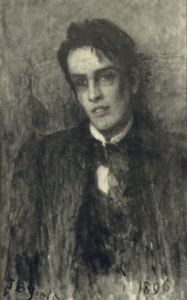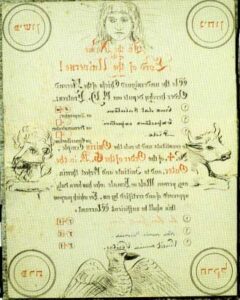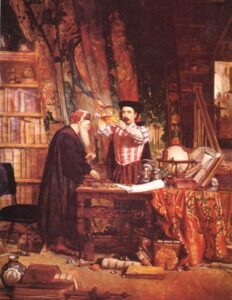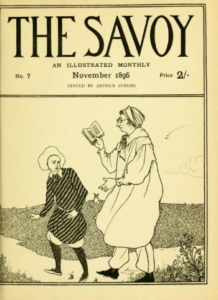Modernity and Occultism in “Rosa Alchemica” and “Tables of the Law” by W.B. Yeats
© Copyright 2019 Emily Mackey, Ryerson University
Introduction to The Savoy and W.B. Yeats

The 1890s is placed in a very interesting time, historically. Both coming out of a revolution and entering into a new millennium, those ten years can be looked at as a transitional period. The threshold aspect of that era, however, cannot be overlooked. In that decade, literature was hit with an introduction of short-fiction, and in the middle of that stood the literary canon of little magazines. Typically published in periodicals, little magazines acted as a means for resistance in the form of art against the status-quo, featuring authors and artists who are known today as defining writers of the era. Specifically, The Savoy, published in 1896, disarmed The Yellow Book and stepped in as a companion and competitor to the original 1890s little magazine (Brake 148). The publication was created out of the shifting world of decadence. In the swirling aftermath of revolution and change, decadence acted as a sort of rebellion against the rigid social rules of the last several hundred years. With a newly powerful middle-class and a start to the questioning of power and control, an opportunity opened up for the entrance of something new and unknown. This was the birth of modernism. While modernism was created out of the wish for leniency, the new rules around working, and the quickly growing mass-production and capitalism, set into place a different type of law, opening a window of opportunity for something new and unusual. Within the pages of The Savoy, renowned poet, William Butler Yeats, helped to bridge that gap with his writing of “Rosa Alchemica” and “Tables of the Law”. These two works demonstrated that modernity, while necessary in the shift of the times, left people yearning for something bigger than themselves. Within The Savoy and for Yeats himself, this came in the form of occultism, allowing for a demonstration of the boundaries of modernity and how those can be tested.
Modernism
In the world of literature, and scholarship surrounding literature, the Victorian and Modernist eras border each other in very close proximity. This provides a very interesting opportunity for scholars to analyze the influence of Modernism and its time period on the literature released in those years. Modernism appeared as the result of what seemed to be an explosion of thought. It was the consequence of the Industrial Revolution and the changes happening across Europe and across the world. It was a time where power was shifting and people were beginning to ask more questions and concern themselves with things often left to the high-class. In a volume of “Literature Compass”, Kristin Mahoney refers to modernism as a need to burst under the pressure of the changes happening around Europe (Mahoney). The birth of Modernism was a reaction, and with every reaction comes multiple others. Modernism was an era that spoke for change. For a full change to occur, there needs to be ripple effects across the board. Modernism ushered in not only changes socially, religiously, and politically, but also in the form of literature. It breathed new life into the short story and opened a realm of possibilities for what can be taken seriously within literary scholarship. Modernist writing was radical in all senses, but especially aesthetically and technologically, placing emphasis on the interweaving of time and place rather than a chronological order (Chids 3). Writers were taking themes that were usually taboo and turning them into art. This art, however, became social commentary. If renowned artists of the time were speaking to something, it opened up conversations around what changes really could be made under Modernism. However, in a time where everything was radical and everyone was striving to grow, expand their thinking, and present themselves as against the grain, there was opportunity for exclusion and frustration that stemmed from the fear of doing something wrong (Evans 1:03-1:05). Often, it is thought that the beginning of a revolution, in any sense, is opportunity for greater inclusion and expression. However, under Modernism, there was still a set standard, as described by Chids, of how that expression can be presented. In the case of this short fiction, and other forms of literature, W.B. Yeats drew a fine line between adhering to the standards of modernity and grasping for something more: occultism.
Occultism, Religion, and Yeats

Religion in Europe is a topic discussed and molded continuously throughout history. In the context of this time period, religion in most of Western Europe was a fight between Catholics and Protestants. Under occultism, religion was not seen as a bad thing, as a lot of occult practices were based off of religious traditions. However, there was a dissatisfaction with the strict boundaries in which religion conformed to, and occultism offered a higher flexibility (Swartz 87-101). A correlation is seen between occult religious views and modernity, as the way that things have always been done is no longer a viable option. There is an unhappiness and an unease in the way that religion is formally practiced, and much like the radical shifts in literature, occultism looked for a radical shift in religious and spiritual beliefs. The way that Yeats speaks to his understanding of occultism is powerfully similar to how mainstream religion has always been talked about, and continues to be talked about today. The relationship of finding something bigger than you to find comfort in, is still there. There was a burning reality that Yeats wanted to discover (Oser 27), and this reality was fostered in his joining of Hermetic Society of Dublin and The Order of the Golden Dawn (Thornton 2). Religion is often taken up in the search of finding meaning and it seems that Yeats was trying to find that exactly. Especially in the joining of the Occult societies, Yeats was providing himself with answers to the question of a burning reality. Finding greater meaning, for Yeats, came in the form of art, specifically his writing. As previously mentioned, art in the Modernism period was breaking boundaries of traditional work and doing so in strides. A specific form of occultism which Yeats speaks frequently about in his works, specifically “Rosa Alchemica”, is alchemy. A common understanding in occultism, specifically in alchemy, is the idea that art is used to

perfect the things that God created (Gorski 5). For Yeats, there is an interweaving of art to create perfection. He used both alchemy and writing to perfect the dialogue around the importance of the natural world. His writing about alchemy and occultism was a deeper conversation about meaning, allowing for Yeats to find that burning reality he so desperately wanted. For Yeats, balance was the most important part of occultism. Specifically, he was interested in the balance between realistic and unrealistic, but also art and modernity (Gorski 4). That balance speaks heavily to how Yeats structures his writing. He mingles Modernism with the occult, creating a sense of confusion around reality and a curiosity for the themes that he is speaking to. This demonstrates his urge for a balance between modernity and occultism, while also being a symbol for the importance of pushing the boundaries of modernism.
“Rosa Alchemica” and “Tables of the Law”
Both set in then-present-day Dublin, “Rosa Alchemica” and “Tables of the Law” are both set up to be modernist stories. They involve everyday characters and settings, as well as both beginning in a casual, day-to-day scene. However, it does not take long for the plot of these stories switch to those that would be found in fantasy. In an essay speaking to the economy of the short story, Winnie Chan brings up an interesting point, speaking to how short stories are the creation of mass culture and the backlash against it (3). For Yeats, his works in The Savoy highlights this. Yeats’ use of The Savoy as a means of transportation for his thoughts and ideas is symbolic in many ways. Most importantly, Yeats is taking a magazine routed in breaking the status quo and pushing limits to speak to the boundaries that can be tested through occultism and modernism. Through “Rosa Alchemica”, these boundaries are seen in The Savoy for the first time. Early in the story the narrator of this plot is visited by an old friend and asked to join the order of the Alchemical Rose. Upon refusal, the narrator is thrusted into an almost dream like state and describes feeling as if he is being torn in two. During this point he says, “your

philosophy is charming as a phantasy, but, carried to a point of belief, it is a supreme delusion, and, enforced by mesmeric glamour, a supreme crime” (Yeats 61). This is the first time that the idea of occultism is pinned against modernity in this story. The narrator acknowledges the allure of occultism but shuts down the idea that it could ever work. For him, even thinking of these acts is a crime in itself, as it goes against present day modernity in all its senses, but specifically in the glamour and decadence that surrounds it. In an attempt to show him differently, the visitor, Michael Robartes, brings the narrator to be sworn into the Order at a ceremony. During this ceremony, Yeats describes the dancers who find love and hope in the personification of alchemy, but how they all soon realize the evil nature of the personifications (Yeats 68-69). There is an evident approach at balance in the way that Yeats writes the plot, in the sense that he never specifically supports the practices of Occultism, but also gives enough insight into them that readers may have found a sense of belonging in the sheer lack of rigidity that occultism provides. Without explicitly promoting occultism, Yeats is indicating to his readers that there is more than what is marketed under modernity. “Tables of the Law” is setup in a very similar way. In this story, the narrator is interacting with a man named Aherne, who left the ministry to pursue Occultism. In his explanation of the occult laws that he follows, Aherne speaks of people who are governed by the Holy Spirit as opposed to God, and how he is in search of laws to guide them through their work (Yeats 188). Although, once again, Yeats is not explicit in his description and approval of the occult practices, the fantasy surrounding the idea of the “Tables of the Law” is enough to draw a curious mind to occultism. For those are may have been struggling with the rigidity of formal religion at this time, reading an alternative would have been groundbreaking. In the end of the story, however, Aherne is distraught under the idea that in his findings of these laws, he has lost the ability to sin, and is therefore no longer protected under God (Yeats 190). As in the previous story, Yeats creates a character who comes to despise the very occult thoughts that surround the narrative. In “Tables of the Law”, he goes as far as to take away the very thing that people found comfort in even under modernism, God’s protection. In both works, Yeats contradicts his beliefs. And while some may critique these works and argue that this is a dialogue around occultism not being sustainable, it really serves as a demonstration of the boundaries of modernity and how those are challenged by occultism. The plots themselves are tests of modernism, to see how the characters would interact within it. However, by contradicting himself, Yeats is saying that yes, occultism is interesting and mind-inducing, but under the confines of modernism, there is an inability to speak about it. This is why The Savoy provides such a helpful outlet for Yeats, as it allows for him to create new conversations in an unassuming way. It provides a deeper understanding than base-value insinuates, proving to show that the boundaries of modernity are able to be tested, and were tested, and should continue to be tested.
Conclusion
In the most successful way possible, Yeats takes the clashing worlds of Modernism and Occultism and puts them together to demonstrate the boundaries that modernity has in a world that strategically saw modernity as the most progressive form of thought at the time. As a sign of the times, these boundaries provided for a lack of information around occultism, and a disinterest in this period of Yeats. Scholars often overlook “Rosa Alchemica” and “Tables of the Law” solely for their lack of a modernist approach to literature (Thornton 1). In a world where he had to have known he would not be taken seriously, Yeats was taking risks by creating stories, plotlines, characters, and settings that all revolved around the occult. For many, it is gibberish, but when taken at more than face-value, Yeats use of the occult in 1890s short-stories, works as a large social commentary surrounding a misunderstood historical time period. In its disapproval of the status-quo, modernity created a new status quo, and that hurt the range of imagination and spiritual expression in the day to day lives of Europeans. The Savoy, in its creation of a threshold market, provided Yeats with the foundation to comment on this lack of expression and the issues surrounding it, demonstrating that the boundaries of modernity can, and should, be tested by occultism.
Images in this online exhibit are either in the public domain or being used under fair dealing for the purpose of research and are provided solely for the purposes of research, private study, or education.
Brake, Laurel. “The Savoy: 1896. Gender in Crisis?” Subjugated Knowledges, 1994, pp. 148-165. Springer Link, https://link.springer.com/chapter/10.1007/978-1-349-23322-9_8
Chan, Winnie. The Economy of the Short Story in British Periodicals of the 1890s. University of Virginia, 2004. ProQuest,
http://ezproxy.lib.ryerson.ca/login?url=https://search-proquest-com.ezproxy.lib.ryerson.ca/docview/305105458?accountid=13631
Childs, Peter. Modernism. Taylor and Francis Group, 2000. ProQuest EBook Central, https://ebookcentral-proquest-com.ezproxy.lib.ryerson.ca/lib/ryerson/reader.action?docID=165767&ppg=1
Daly, Nicholas. Modernism, Romance and the Fin de Siècle: Popular Fiction and British Culture. Cambridge University Press, 2000. ProQuest EBook Central, https://ebookcentral-proquest-com.ezproxy.lib.ryerson.ca/lib/ryerson/reader.action?docID=147312&ppg=1
Evans, Richard. “The Victorians: Religion and Science.” The Victorians: Culture and Experience in Britain, Europe and the World 1815-1914. Museum of London, 2011, England. Lecture.
Mahoney, Kristin. “The “Transition to Modernism”: Recent Research on the Victorian/Modern Divide.” Literary Compass, vol. 10, no. 9, 2013, pp.716-725. Wiley Online Library, https://doi-org.ezproxy.lib.ryerson.ca/10.1111/lic3.12090
Oser, Lee. The Ethics of Modernism: Moral Ideas in Yeats, Eliot, Joyce, Woolf and Beckett. Cambridge University Press, 2007. ProQuest Ebook Central, https://ebookcentral-proquest-com.ezproxy.lib.ryerson.ca/lib/ryerson/detail.action?docID=288491.
Swartz, Laura. “Occulture: W.B. Yeats’ prose fiction and the late nineteenth- and early twentieth-century occult revival.” Ball State University, 2010. ProQuest
http://ezproxy.lib.ryerson.ca/login?url=https://search-proquest-com.ezproxy.lib.ryerson.ca/docview/594663746?accountid=13631
Thornton, Weldon. “Between Circle and Straight Line: A Pragmatic View of W.B. Yeats and the Occult.” Study in the Literary Imagination, vol. 14, no. 1, 1981, pp. 61-76. ProQuest,
http://ezproxy.lib.ryerson.ca/login?url=https://search-proquest-com.ezproxy.lib.ryerson.ca/docview/1303455823?accountid=13631
Yeats, W. B. “Rosa Alchemica.” The Savoy, vol. 2, Apr. 1896, https://archive.org/stream/savoy01symo/#page/56/mode/2up/search/alchemica.
Yeats, W. B. “Tables of the Law.” The Savoy, vol. 7, Nov. 1896, https://archive.org/stream/savoy03symo/#page/n107/mode/2up/search/tables+of+the+law.
